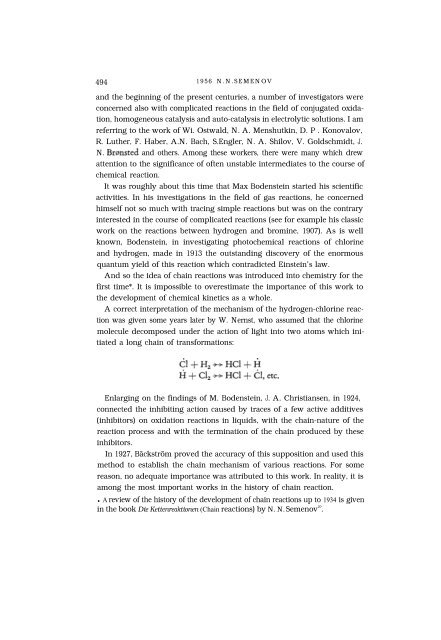Nikolai N. Semenov - Nobel Lecture - Nobelprize.org
Nikolai N. Semenov - Nobel Lecture - Nobelprize.org
Nikolai N. Semenov - Nobel Lecture - Nobelprize.org
Create successful ePaper yourself
Turn your PDF publications into a flip-book with our unique Google optimized e-Paper software.
494 1956 N.N.SEMENOV<br />
and the beginning of the present centuries, a number of investigators were<br />
concerned also with complicated reactions in the field of conjugated oxidation,<br />
homogeneous catalysis and auto-catalysis in electrolytic solutions. I am<br />
referring to the work of Wi. Ostwald, N. A. Menshutkin, D. P . Konovalov,<br />
R. Luther, F. Haber, A.N. Bach, S.Engler, N. A. Shilov, V. Goldschmidt, J.<br />
N. Brernsted and others. Among these workers, there were many which drew<br />
attention to the significance of often unstable intermediates to the course of<br />
chemical reaction.<br />
It was roughly about this time that Max Bodenstein started his scientific<br />
activities. In his investigations in the field of gas reactions, he concerned<br />
himself not so much with tracing simple reactions but was on the contrary<br />
interested in the course of complicated reactions (see for example his classic<br />
work on the reactions between hydrogen and bromine, 1907). As is well<br />
known, Bodenstein, in investigating photochemical reactions of chlorine<br />
and hydrogen, made in 1913 the outstanding discovery of the enormous<br />
quantum yield of this reaction which contradicted Einstein’s law.<br />
And so the idea of chain reactions was introduced into chemistry for the<br />
first time*. It is impossible to overestimate the importance of this work to<br />
the development of chemical kinetics as a whole.<br />
A correct interpretation of the mechanism of the hydrogen-chlorine reaction<br />
was given some years later by W. Nernst, who assumed that the chlorine<br />
molecule decomposed under the action of light into two atoms which initiated<br />
a long chain of transformations:<br />
Enlarging on the findings of M. Bodenstein, J. A. Christiansen, in 1924,<br />
connected the inhibiting action caused by traces of a few active additives<br />
(inhibitors) on oxidation reactions in liquids, with the chain-nature of the<br />
reaction process and with the termination of the chain produced by these<br />
inhibitors.<br />
In 1927, Bäckström proved the accuracy of this supposition and used this<br />
method to establish the chain mechanism of various reactions. For some<br />
reason, no adequate importance was attributed to this work. In reality, it is<br />
among the most important works in the history of chain reaction.<br />
• A review of the history of the development of chain reactions up to 1934 is given<br />
in the book Die Kettenreaktionen (Chain reactions) by N. N. <strong>Semenov</strong> 20 .
















